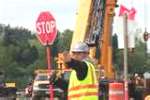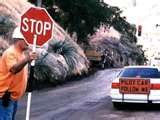
Flagging Hazards Away
 Factors that cause traffic collisions include driver error, poor visibility, road surface conditions, and inadequate traffic controls. According to OSHA, 1,000 people are killed in temporary traffic control work zones around the country every year, and 90 percent of those crashes are the direct result of driver error.
Factors that cause traffic collisions include driver error, poor visibility, road surface conditions, and inadequate traffic controls. According to OSHA, 1,000 people are killed in temporary traffic control work zones around the country every year, and 90 percent of those crashes are the direct result of driver error.
"OSHA can fine you for a direct violation of their regulations, for violating a regulation that refers to another standard, and for not following the manufacturers' specifications," said Jerry Bach, vice president and an instructor at the Sacramento, Calif.-based Safety Center Inc. "But regardless of fines from OSHA, we make sure we're working safely because we want the worker to go home at the end of the day."
During his temporary traffic control training sessions, Bach stresses the importance of accountability, safety, and keeping an eye on traffic. "If you don't have enough cones, get some more. Not enough signs? Get more. Not enough people? Get some more. There is no excuse for a government agency: It's all about accountability, and supervisors can be held responsible for not providing enough employees to get the job done," Bach said.
Flagging
Flaggers should be trained by persons with the qualifications and experience necessary to effectively instruct the employee in the proper fundamentals of flagging and moving traffic. Qualifications for flaggers include the ability to communicate specific instructions, maneuver quickly to avoid danger, control signaling devices to provide clear guidance, understand and apply safe traffic practices, and recognize dangerous situations and warn others.
"The worst thing to do is to have someone out there that would freeze in the event of an emergency," Bach says. "You want to protect yourself first, then your buddies, then the public."
Flaggers should be equipped with a STOP/SLOW paddle that is at least 18 inches wide with 6-inch letters. Flaggers also should at all times have a whistle, pencil, note pad, two-way radio, drinking water, and additional clothing in case of a climate change. At night, flaggers also should have reflectorized gloves and carry a flashlight with wand and batteries. Flagger stations must be located so that approaching road users will have a sufficient distance to stop at an intended stopping point. There should also be a light provided to illuminate the flagger station.
Police and fire should be notified in advance if the roadwork will make the roadway impassable so that they can send their personnel through alternative routes in case of an emergency. If an emergency vehicle approaches the work area with advance warning, the flagger should stop traffic in all directions. If the flagger does not have advance warning, he or she should stop the emergency vehicle first and then stop all traffic, including construction equipment, to clear a path.
When a driver violates the flagger's warnings and trespasses flagging stations, it is important that the flagger warn the workers ahead of him. A warning signal should be established for the work area crew in case of an emergency. It also is important for the flagger to know how to handle violations of traffic control, crashes, and accidents within traffic control zones and emergency flagging operations. "It is important to not have a false sense of security and to have an escape plan in case something goes wrong," Bach says.
Flaggers will occasionally have to deal with hostile drivers in a traffic control zone and should avoid confrontation with them. Flaggers thus should be informed about the road work being performed, they should smile at the angry motorist, agree or empathize with the motorist, avoid extended eye contact, and be courteous and professional. "If they can't speak the language of the people driving through, they can't be a flagger," Bach says.
If a motorist fails to follow a flagger's instructions or threatens the safety of the work area, the flagger should take down the license plate number and description of the car and report it to a supervisor for the purpose of contacting police. "You can't trust the public to follow signs or a flagger's directions. You can't expect them to do what they are supposed to do, so you have to take the necessary precautions," Bach says.
Traffic Control
Traffic control for each situation depends on the type of highway, driving conditions, duration of operation, physical constraints, and the distance between the workspace and the drivers. To ensure successful traffic control, equipment used to communicate with motorists and pedestrians should cover the nature of the work, explain the duration of the project, address anticipated effects on road users, and offer alternative routes of travel or modes of transportation.
Here are the fundamental principles of temporary traffic control:
- A traffic control plan, in detail, appropriate to the complexity of the work project or incident, should be prepared and understood by all responsible parties.
- Individuals knowledgeable in principles of proper traffic control should be assigned responsibility for safety in the traffic control zone.
- As the work progresses and conditions change, the traffic control plan should be modified to provide reasonably safe and efficient road user movement and worker safety.
"If a cone or a sign falls down and something happens, you're liable," Bach notes. Each person whose actions affect the traffic zone's safety, from upper level management to the field workers, should receive training appropriate to the job. All traffic control devices should be removed once they are no longer needed. When work is suspended for short periods of time, traffic control devices that are no longer necessary should be removed or covered.
There are four areas to consider in making a temporary traffic control plan.
1. Advance warning area.
2. Transition area: a section of the highway where road users are redirected out of their normal path; this area involves strategic use of tapers.
3. Activity area: the section of the highway where the work activity takes place. It is comprised of:
- Buffer space: The area that separates road user flow from the work space or unsafe area, providing recovery space for an errant vehicle.
- Work space: The portion of the highway that is closed to road users and set aside for workers and equipment by channelizing devices.
- Traffic space: The area where cars are permitted to travel.
4. Termination area: a section extended from the downstream end of the work area to the last traffic control device, used to return drivers to their normal path.
Tapers are created by using a series of channelizing devices and/or pavement markings to move traffic into or out of the normal path. Longer tapers are not always better than shorter because they may make drivers delay lane changes.
Channelizing devices are used to warn drivers of conditions created by work activities in or near the roadway and to guide drivers. Channelizing devices include cones, tubular markers, vertical panels, drums, barricades, and temporary raised islands. Cones should be predominantly orange and made of material that will not cause damage if struck by a vehicle. For daytime or low speed use, cones must be at least 18 inches, and cones used at nighttime and in high speed areas should be 28 inches.
"The whole purpose of advanced warning is to give the motorist time to react. If the signs are too close together, they won't do any good," Bach says.
A standard barricade should have stripes on the rails that shall be alternating orange and white retro-reflective stripes sloping downward at an angle of 45 degrees. The stripes should be 6 inches wide. A guidance barrier should have stripes sloping downward at a 45 degree angle in the direction road users are to pass. According to OSHA, a pedestrian route shall not be severed and/or moved for non-construction activities such as parking for equipment and vehicles.
Work Duration
Most maintenance and utility operations are short-term stationary work. It often takes longer to set up and remove traffic control devices than to perform the work. "The few minutes it takes to set up the devices are worth it if you can keep someone from getting hurt," Bach says.
A reduction in the number of devices may be offset by the use of other more dominant devices such as high-intensity rotating, flashing, oscillating, or strobe lights on work vehicles. "It's important that safety is not compromised in short-duration or mobile operations. Don't use fewer devices simply because the operation will frequently change its location," Bach says.
Long-term stationary work occupies a location for more than three days. Intermediate-term stationary work occupies a location for more than one daylight period (up to three days) or nighttime work lasting more than one hour. Short-term stationary work is daylight work that occupies a location for more than one hour within a single daylight period. Short-duration work occupies a location for up to one hour.
"Ultimately, if you can control traffic with signs and cones, don't put a flagger out there and expose your workers to danger," Bach says. "And workers need to remember that they can refuse to do something unsafe."
This article originally appeared in the January 2009 issue of Occupational Health & Safety.